Sorption of Organic Electrolytes and Surfactants from Natural Waters by Heterogeneous Membranes
Abstract
1. Introduction
2. Materials and Methods
2.1. The Volumetric Properties of Organic Electrolyte Solutions
2.2. The Total Ion Exchange Capacity of Membranes
- V1 is the volume of HCl (NaOH) (cm3) when titrated with a membrane;
- V0 is the volume of HCl (MNaOH) (cm3) when titrated without a membrane;
- C is the concentration of HCl (NaOH) solution (g-equiv/l);
- m is the weight of the membrane, g.
2.3. Determination of the Membrane Moisture Content
- Psw and P0 are the weights of the swollen and dry membrane;
- a/ and a// are the moisture content calculated for 1 g of dry and 1 g of wet membrane respectively. The error of determination is ±0.01.
2.4. Determination of Transport Numbers in the Nembranes was Conducted by Measuring the Membrane Potential
| (-) Ag/AgCl: | test solution membrane: | test solution: | AgCl/Ag (+) |
| C1 | C2 |
3. Results and Discussion
Exchange Capacity and Sorption of Organic Ions
- (τ) is the share of filling the ionite with an organic ion;
- d is the thickness of the membrane;
- τ is the filling time;
- membrane diffusion coefficients (D) were estimated for these ions.
4. Conclusions
Author Contributions
Funding
Conflicts of Interest
References
- Martsenyuk, V.; Petruk, V.G.; Kvaternyuk, S.M.; Pohrebennyk, V.; Petruk, R.V.; Klos-Witkowska, A. Multispectral control of water bodies for biological diversity with the index of phytoplankton. In Proceedings of the 16th International Conference on Control, Automation and Systems, ICCAS, HICO, Gyeongju, South Korea, 16–19 October 2016; pp. 988–993. [Google Scholar]
- Ishchenko, V.; Pohrebennyk, V.; Kozak, Y.; Kochanek, A.; Politylo, R. Assessment of batteries influence on living organisms by bioindication method. In Proceedings of the 16th International Multidisciplinary Scientific GeoConference, Albena, Bulgaria, 30 June–6 July 2016; pp. 85–92. [Google Scholar]
- Mitryasova, O.; Pohrebennyk, V. Integrated environmental assessment of the surface waters pollution: Regional aspect. In Proceedings of the International Multidisciplinary Scientific GeoConference SGEM, Vienna, Austria, 27–29 November 2017; pp. 235–242. [Google Scholar]
- Pohrebennyk, V.; Petryk, A. The degree of pollution with heavy metals of fallow soils in rural administrative units of Psary and Płoki in Poland. In Proceedings of the 17th International Multidisciplinary Scientific GeoConference, SGEM, Albena, Bulgaria, 29 June–5 July 2017; Volume 17, pp. 967–974. [Google Scholar]
- Pohrebennyk, V.; Mitryasova, O.; Klos-Witkowska, A.; Dzhumelia, E. The Role of Monitoring the Territory of Industrial Mining and Chemical Complexes at the Stage of Liquidation. In Proceedings of the 17th International Multidisciplinary Scientific GeoConference SGEM 2017, Vienna, Austria, 27–29 November 2017; Volume 17, pp. 383–390. [Google Scholar]
- Mitryasova, O.; Pohrebennyk, V.; Kardasz, P. Hydrochemical aspects of surface water quality assessment. In Proceedings of the 18th International Multidisciplinary Scientific Geoconference, SGEM 2018, Albena, Bulgaria, 2–8 July 2018; Volume 18, pp. 513–520. [Google Scholar]
- Bejanidze, I.; Pohrebennyk, V.; Kharebava, T.; Koncelidze, Z.; Jun, S. Development of waste-free, eco-pure combined technology for fruit processing. In Proceedings of the International Multidisciplinary Scientific GeoConference SGEM, Albena, Bulgaria, 30 June–6 July 2019; Volume 19, pp. 173–180. [Google Scholar]
- Bejanidze, I.; Pohrebennyk, V.; Kharebava, T.; Koncelidze, L.; Sun, J. Correction of the chemical composition of the washing waters received as a result of h cation exchange of ionex change resin. In Proceedings of the International Multidisciplinary Scientific GeoConference SGEM, Albena, Bulgaria, 30 June–6 July 2019; Volume 19, pp. 133–140. [Google Scholar]
- Bejanidze, I.; Kardash, P.; Pohrebennyk, V.; Kharebava, T.; Didmanidze, N. Influence of technological parameters of ultrafiltration process of vegetable juices on their quality. In Proceedings of the International Multidisciplinary Scientific GeoConference SGEM, Albena, Bulgaria, 30 June–6 July 2019; Volume 19, pp. 321–328. [Google Scholar]
- Prokopenko, O.; Eremenko, Y.; Omelyanenko, V. Role of international factor in innovation ecosystem formation. Econ. Ann. XXI 2014, 3–4, 4–7. [Google Scholar]
- Prokopenko, O.; Kysly, V.; Shevchenko, H. Peculiarities of the natural resources economic estimation under the transformational conditions. Econ. Ann. XXI 2014, 7, 40–43. [Google Scholar]
- Voutchkov, N.; Kaiser, G. Management of Concentrate from Desalination Plants, 1st ed.; Elsevier Science: Amsterdam, The Netherlands, 2020; 292p, ISBN 978-0128180457. [Google Scholar]
- Edser, C. An International Newsletter Monitoring Technical and Commercial Developments for all Surface Active. Focus Surfactants 2020, 12, 1351–4210. [Google Scholar]
- Hayes, H.; Solaiman, D.; Ashby, R. Biobased Surfactants. Synthesis, Properties, and Applications, 2nd ed.; Academic Press; AOCS Press: Cambridge, MA, USA, 2019; p. 541. ISBN 978-0128127056. [Google Scholar]
- Drioli, E.; Criscuoli, A.; Curcio, E. Membrane Contactors: Fundamentals, Applications and Potentialities. In Membrane Science and Technology Science, 1st ed.; Elsevier Science: Amsterdam, The Netherlands, 2005; Volume 11, p. 516. [Google Scholar]
- Bejanidze, I. Save natural-save your life. Ga. Natl. Sci. Acad. Bull. 2010, 36, 76–84. [Google Scholar]
- Mikhaylin, S.; Bazinet, L. Fouling on ion-exchange membranes: Classification, characterization and strategies of prevention and control. Adv. Colloid Interface Sci. 2016, 229, 34–56. [Google Scholar] [CrossRef]
- Möbius, D.; Miller, R.; Fainerman, R. Surfactants: Chemistry, Interfacial Properties, Applications; Elsevier Science: Amsterdam, The Netherlands, 2001; Volume 13, p. 678. [Google Scholar]
- Sillanpaa, M. Advanced Water Treatment, Adsorption, 1st ed.; Elsevier Science: Amsterdam, The Netherlands, 2020; p. 694. [Google Scholar]
- Charcosset, A. Membrane Processes in Biotechnology and Pharmaceutics; Elsevier: Amsterdam, The Netherlands, 2012; p. 350. [Google Scholar]
- Kotelnikova, I.; Golovashin, V.; Lazarev, S. Investigation of the kinetic characteristics of membrane separation of solutions containing surfactants and petroleum products. Bull. Tambov Univ. Ser. Nat. Tech. Sci. 2012, 2, 685–687. (In Russian) [Google Scholar]
- Singh, R.S.; Hankins, N. Emerging Membrane Technology for Sustainable Water Treatment; Elsevier Science: Amsterdam, The Netherlands, 2016; p. 480. [Google Scholar]
- Khorokhorina, I.; Lazarev, S. Sorption of anionic surfactants from an aqueous solution. In Proceedings of the XIV Conference with International Participation, Voronezh, Russia, 3–5 April 2014; pp. 327–328. (In Russian). [Google Scholar]
- Kurenkova, O. Methods for purifying water from surfactants. In Scientific Bulletin of the Voronezh State University of Architecture and Civil Engineering; Physico-chemical problems of building materials science and high technology Series; VSU: Voronezh, Russia, 2001; Volume 3–4, pp. 66–79. (In Russian) [Google Scholar]
- Markova, O. Investigation on the Concentrating, Separation and Toxic Properties of Surfactants and Their Metabolites in Water. Ph.D. Thesis, Astrakhan State University, Astrakhan, Russia, 2004. (In Russian). [Google Scholar]
- Zubkova, G.; Kravtsov, Y.; Lebedeva, A. Comparative Efficiency of Cleaning Solutions from Surfactants by the Sorption Method and Electro-Flotocoagulation. Nauka; Collection of Articles; Publishing House of TsNTEP: Astrakhan, Russia, 2002; pp. 249–251. (In Russian) [Google Scholar]
- Basile, A.; Cassano, A.; Rastogi, N. Advances in Membrane Technologies for Water Treatment, 1st ed.; Elsevier: Amsterdam, The Netherlands, 2012; p. 666. [Google Scholar]
- Strathmann, H. Ion-Exchange Membrane Separation Processes Membrane Science and Technology, Volume 9; Elsevier Science: Amsterdam, The Netherlands, 2003; p. 360. [Google Scholar]
- Strathmann, H. Electrodialysis, a mature technology with a multitude of new applications. Desalination 2010, 264, 268–288. [Google Scholar] [CrossRef]
- Tran, A.; Zhang, Y.; Lin, J.P.; Mondal, P.; Meesschaert, W.; Pinoy, L.; Van der Bruggen, B. Phosphate pre-concentration from municipal wastewater by electrodialysis: Effect of competing components. Sep. Purif. Technol. 2015, 141, 38–47. [Google Scholar] [CrossRef]
- Norman, N. Advanced Membrane Technology and Applications; Wiley-Interscience: Hoboken, NJ, USA, 2008; p. 994. [Google Scholar]
- Kononenko, N. Electro-Membrane Systems with Surfactants. Ph.D. Thesis, KSU, Krasnodar, Russia, 2019. (In Russian). [Google Scholar]
- Bejanidze, I.; Mgeladze, E.; Mgeladze, M. Indrustrial sewage-the source of ecological aids. In Collection of works of International Conference, Proceedings of the 3rd International Conference of Young Scientists “Chemistry Today“, Tbilisi, Georgia, 17–19 May 2013; pp. 27–28. [Google Scholar]
- Sogaard, E. Chemistry of Advanced Environmental Purification Processes of Water, 1st ed.; Fundamentals and Applications; Elsevier Science: Amsterdam, The Netherlands, 2014; p. 360. [Google Scholar]
- Berezina, N. Electrochemistry of Membrane Systems; Kuban State University: Krasnodar, Russia, 2009. [Google Scholar]
- Yaroslavtsev, A.; Nikonenko, V.; Zabolotsky, V. Ion transfer in membrane and ion-exchange materials. Achievments Chem. 2003, 72, 438–470. (In Russian) [Google Scholar] [CrossRef]
- Ran, J.; Wu, L.; He, Y.; Yang, Z.; Wang, Y.; Jiag, C.; Ge, L.; Bakangura, E.; Xu, T. Ion exchange membranes: New developments and applications. J. Membr. Sci. 2017, 522, 267–291. [Google Scholar] [CrossRef]
- Thomas, S.; Runcy, W.; Kumar, A.; Soney, S. Transport Properties of Polymeric Membranes, 1st ed.; Elsevier Science: Amsterdam, The Netherlands, 2017; p. 724. [Google Scholar]
- Kotelnikova, I.; Kostyleva, M. Investigation on the kinetic characteristics of the membrane separation of solutions containing surfactants/Science and education for the sustainable development of the economy, nature and society: Proceedings of the V.I. In Proceedings of the Vernadsky International Scientific Conference, Tambov, Russia, 6–8 June 2013; pp. 95–98. (In Russian). [Google Scholar]
- Auclair, B.; Archet, C.; Dammak, L.; Nikonenko, V.; Métayer, M. Correlation between transport parameters of ion-exchange membranes. J. Membr. Sci. 2002, 195, 89–102. [Google Scholar] [CrossRef]
- Bejanidze, I.; Kharebava, T. Separation of ions by polymer. In Collection of Works of International Conference, Proceedings of the 4th International Conference on Polymer & Advanced Materials, Batumi, Georgia, 1–4 July 2015; Tbilisi State University: Tbilisi, Georgia; p. 71.
- Wenten, G.; Khoiruddin, A. Recent developments in heterogeneous ion-exchange membrane: Preparation, modification, characterization and performance evaluation. J. Eng. Sci. Technol. 2016, 11, 916–934. [Google Scholar]
- Tanaka, Y. Ion Exchange Membranes Fundamentals and Applications, 2nd ed.; Elsevier Science: Amsterdam, The Netherlands, 2015; p. 552. [Google Scholar]
- Lange, K. Surfactants: Synthesis, Properties, Application Analysis; Profession: St. Petersburg, Russia, 2004; p. 240. (In Russian) [Google Scholar]
- Jae-Hwan, C.; Kim Sung-Hye, V.; Seung-Hyeon, M. Heterogeneity of ion-exchange membranes: The effects of membrane heterogeneity on transport properties. J. Colloid Interface Sci. 2001, 241, 120–126. [Google Scholar]
- Bejanidze, I.; Mgeladze, E.; Mgeladze, M. Clean sea water—A merit of electrodialysis. In Collection of Works of International Conference, Proceedings of the 4th International Conference of Young Scientists ”Chemistry Today”; TPU: Tbilisi, Georgia, 2013; pp. 115–116. [Google Scholar]
- Berezina, N.; Timofeev, S.; Kononenko, N. Effect of conditioning techniques of perfluorinated sulphoca-tionic membranes on their hydrophylic and electrotransport properties. J. Membr. Sci. 2002, 209, 509–518. [Google Scholar] [CrossRef]
- Alekseev, Y. Problems and ways to intensify wastewater treatment from biologically resistant organic pollutants. News of higher education institutions. Stroitelstvo 2002, 8, 77–80. (In Russian) [Google Scholar]
- Bejanidze, I.; Kharebava, T.; Koncelidze, Z.; Gorjeladze, D. Study of the possibility of membrane regeneration without disassembly of the electrolytic device. Bull. Georgian Acad. Agric. Sci. 2007, 19, 199–202. (In Georgian) [Google Scholar]
- Alekseev, Y. Research and development of processes of physicochemical wastewater treatment containing surfactants. Dissertation abstract, Moscow State University of Civil Engineering, Moscow, Russia, 2004. (In Russian). [Google Scholar]
- Awaleh, M.; Soubaneh, Y. Waste Water Treatment in Chemical Industries: The Concept and Current Technologies. Hydrol Curr. Res. 2014, 5, 164. [Google Scholar] [CrossRef]
- Bejanidze, I.; Kharebava, T.; Koncelidze, Z.; Verulidze, G. The inapplicability of the classical concepts of transfer numbers to electro membrane systems. Bull. Georgian Acad. Agric. Sci. 2007, 19, 217–218. (In Georgian) [Google Scholar]
- Tien, C. Introduction to Adsorption. Basics, Analysis, and Applications; Elsevier Science: Amsterdam, The Netherlands, 2018; p. 216. [Google Scholar]
- Terekhova, E. Intensification of wastewater treatment from surfactants. Dissertation abstract, Far Eastern State Transport University, Khabarovsk, Russia, 2004. (In Russian). [Google Scholar]
- Bejanidze, I.; Kharebava, T.; Koncelidze, Z.; Verulidze, G. Kinetic characteristics of ion-exchange membranes in solutions of simple and organic electrolytes. Bull. Georgian Acad. Agric. Sci. 2007, 19, 212–216. (In Georgian) [Google Scholar]
- Choi, S.; Yu, J.; Kweon, J. Electrodialysis for desalination of brackish groundwater in coastal areas of Korea. Desalin. Water Treat. 2013, 51, 6230–6237. [Google Scholar] [CrossRef]
- Nayak, S. Fundamentals of Optimization Techniques with Algorithms; Academic Press: Cambridge, MA, USA, 2020; p. 300. [Google Scholar]
- Luis, P. Fundamental Modeling of Membrane Systems. Membrane and Process Performance; Elsevier Science: Amsterdam, The Netherlands, 2018; p. 371. [Google Scholar]
- Camacho, L.; Fox, J.; Ajedegba, J. Optimization of electrodialysis metathesis (EDM) desalination using factorial design methodology. Desalination 2017, 403, 136–143. [Google Scholar] [CrossRef]
- Van Geluwe, S.; Braeken, L.; Robberecht, T.; Jans, M.; Creemers, S.; Van der Bruggen, B. Evaluation of electrodialysis for scaling prevention of nanofiltration membranes at high water recoveries. Resour. Conserv. Recycl. 2011, 56, 34–42. [Google Scholar] [CrossRef]
- Bejanidze, I.; Kharebava, T.; Koncelidze, Z.; Chikovani, D. Monograph: In Processing of the Fruits by the Waste-Free Ecologically Clean Complex Technology; LTD Grafi: Batumi, Georgia, 2017; p. 426. (In Georgian) [Google Scholar]
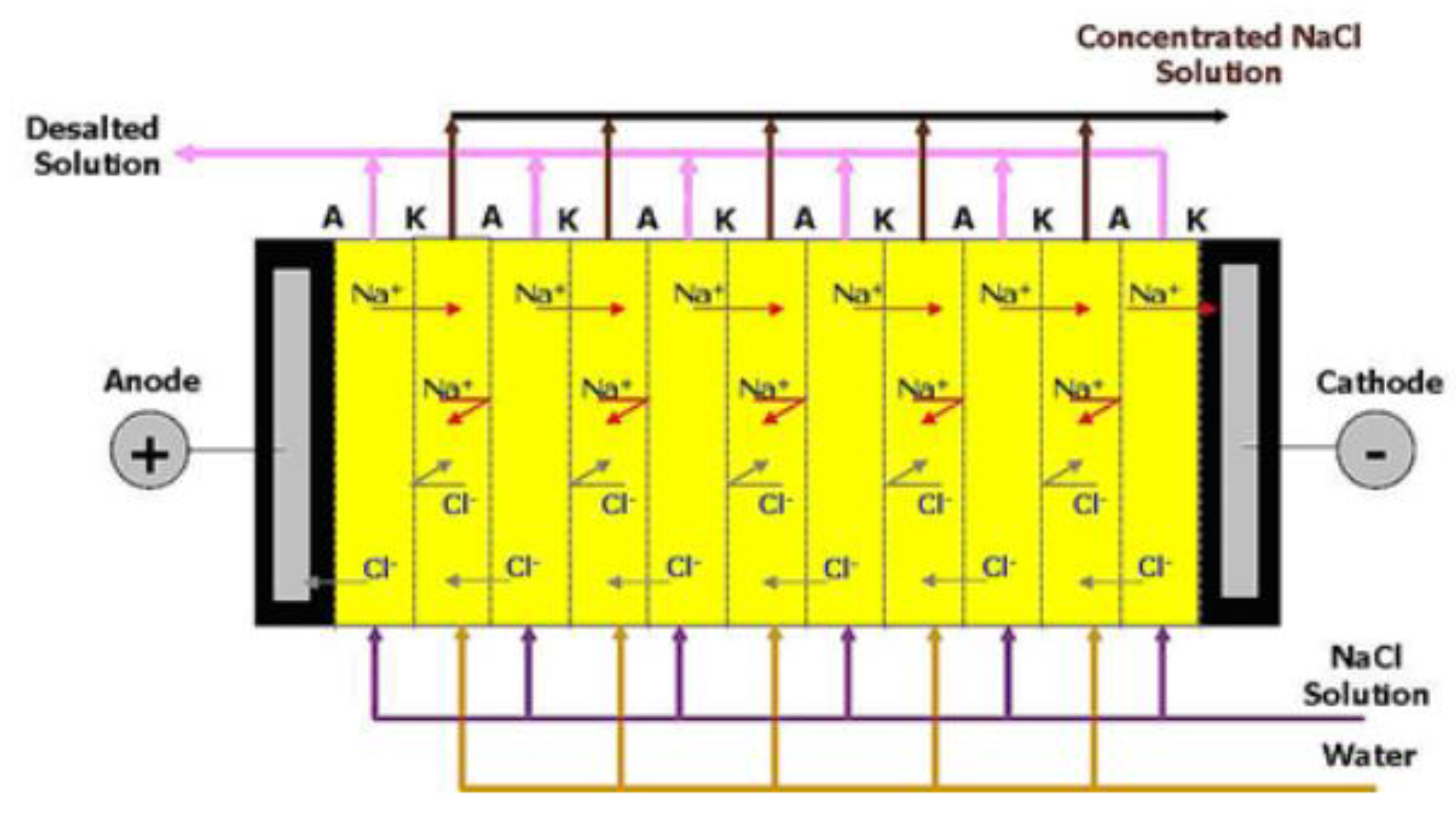
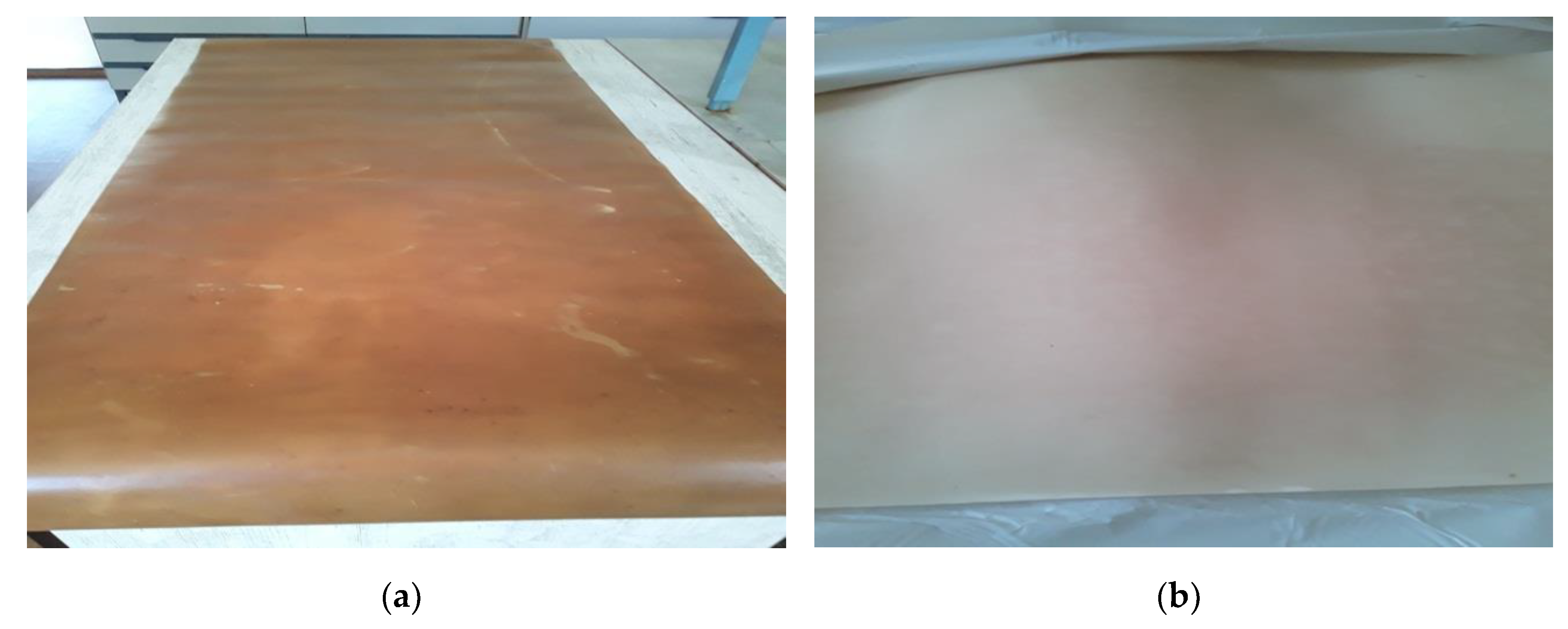

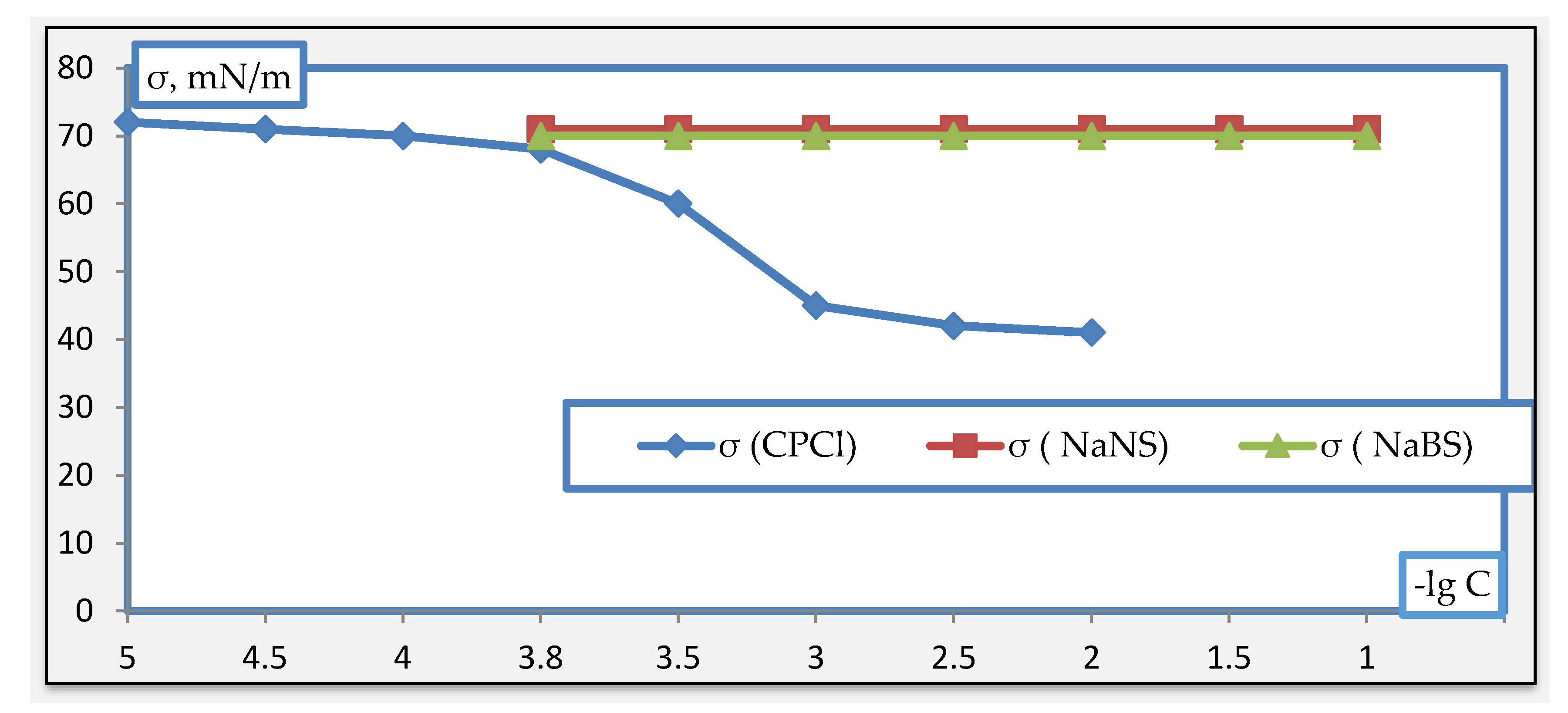
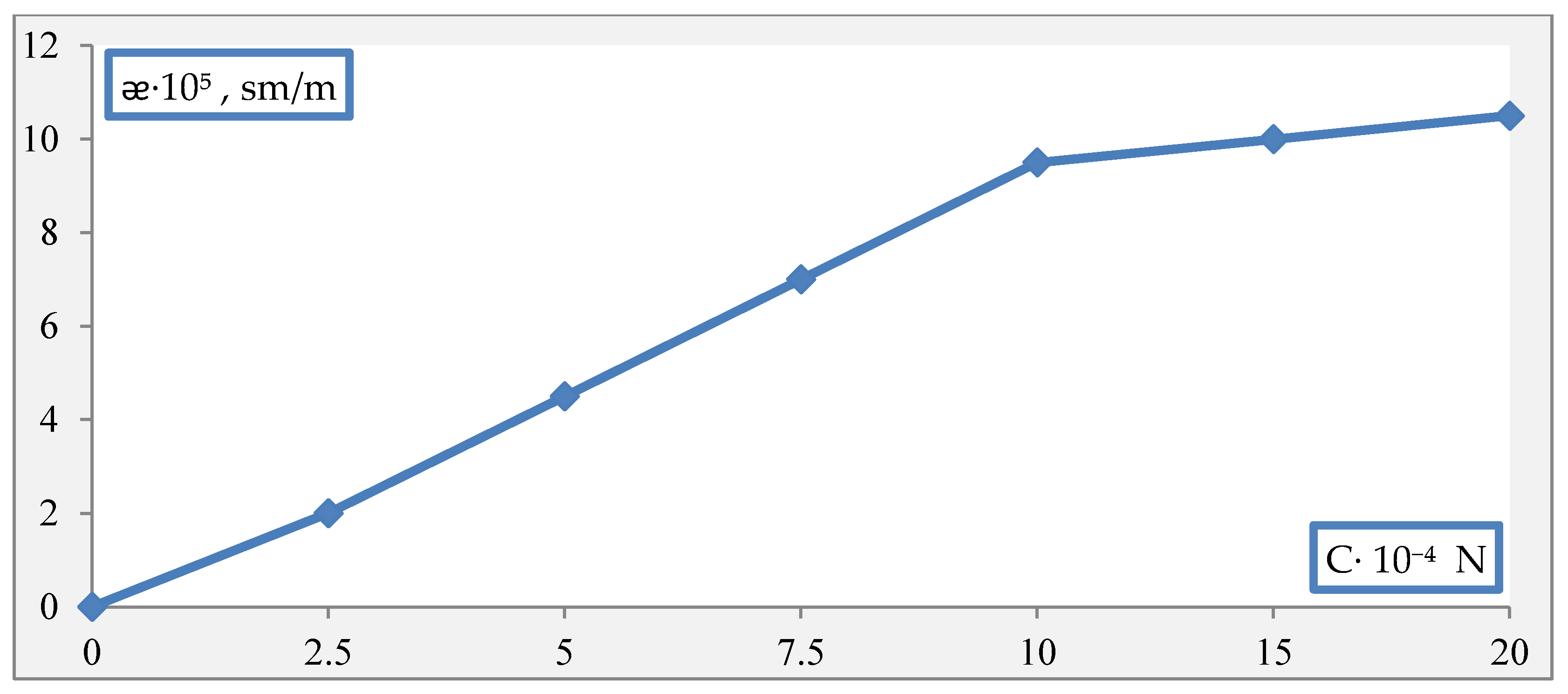
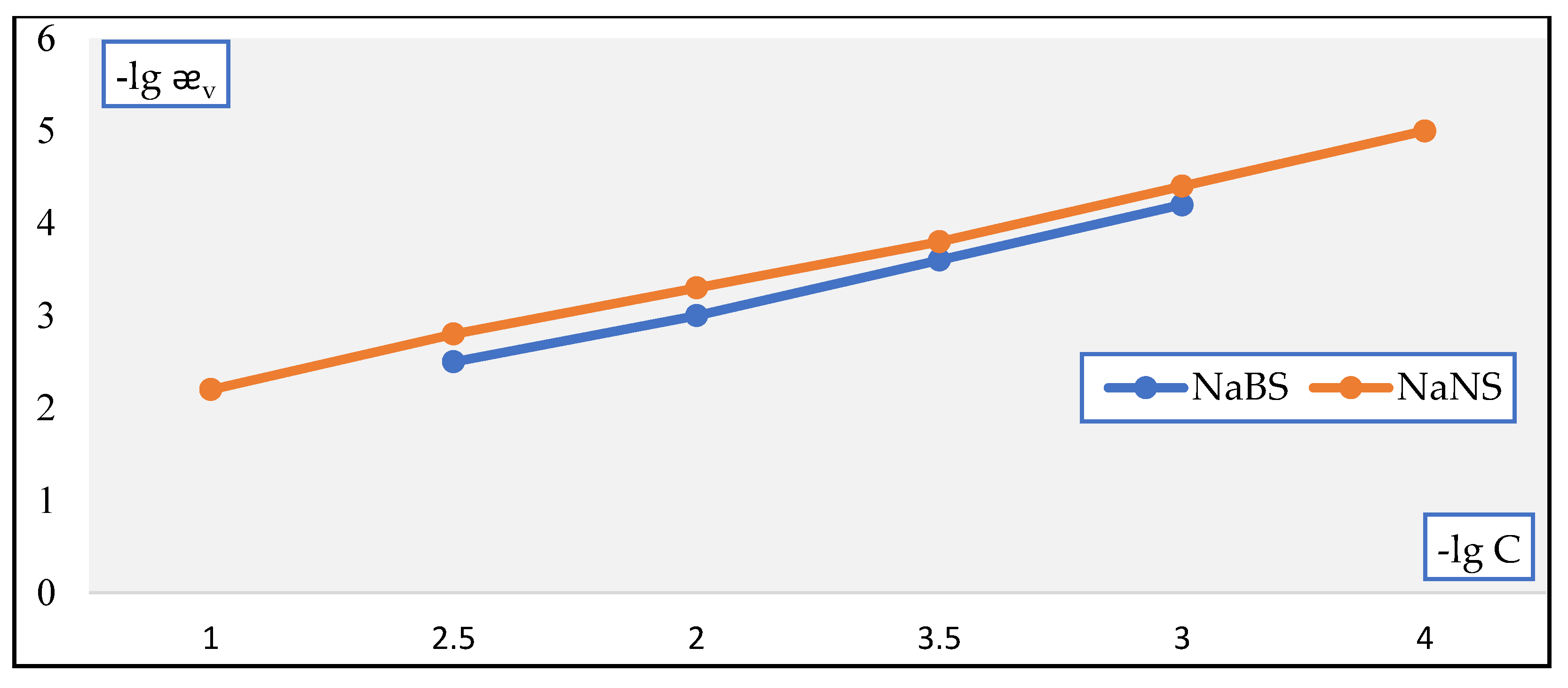
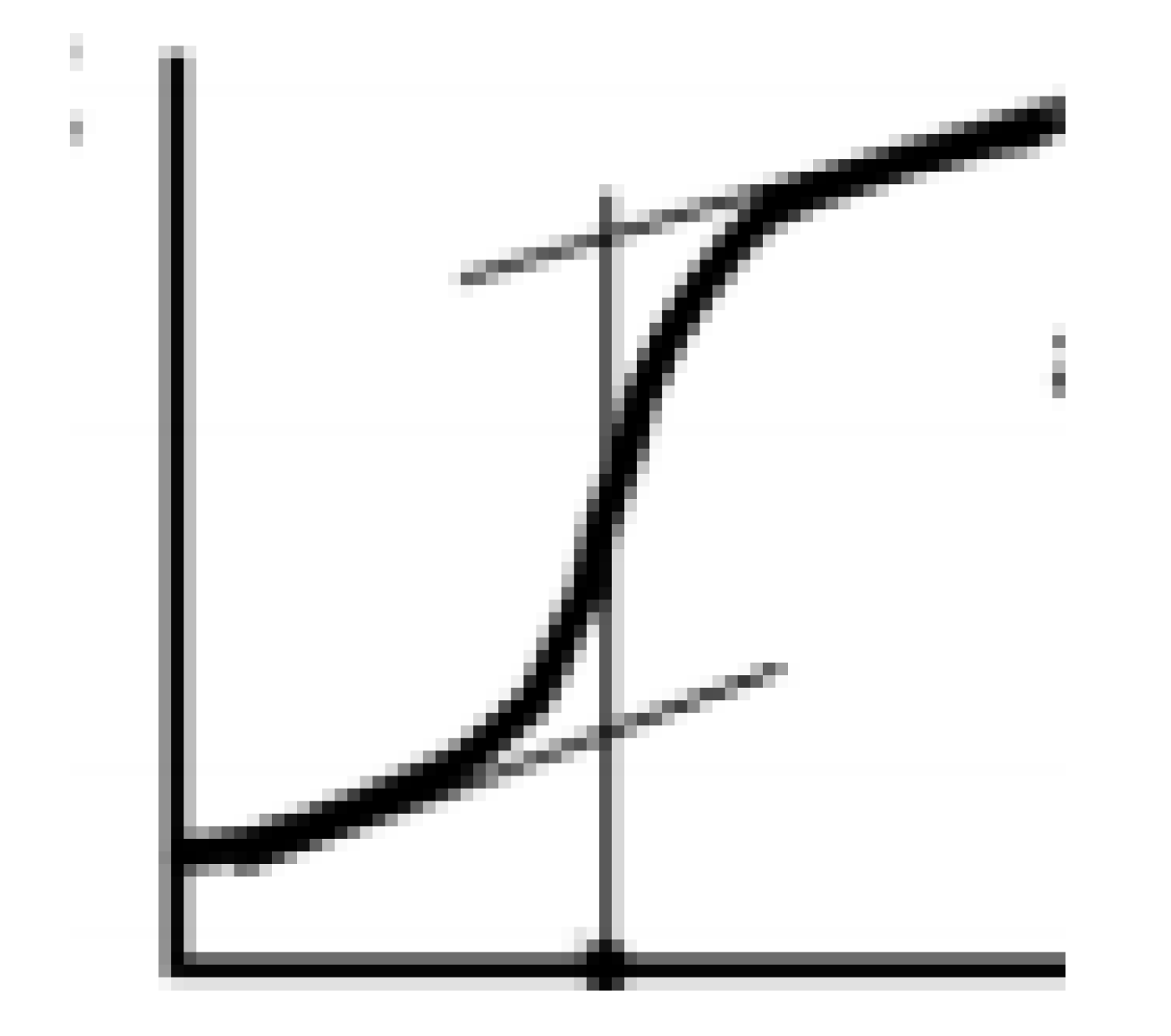
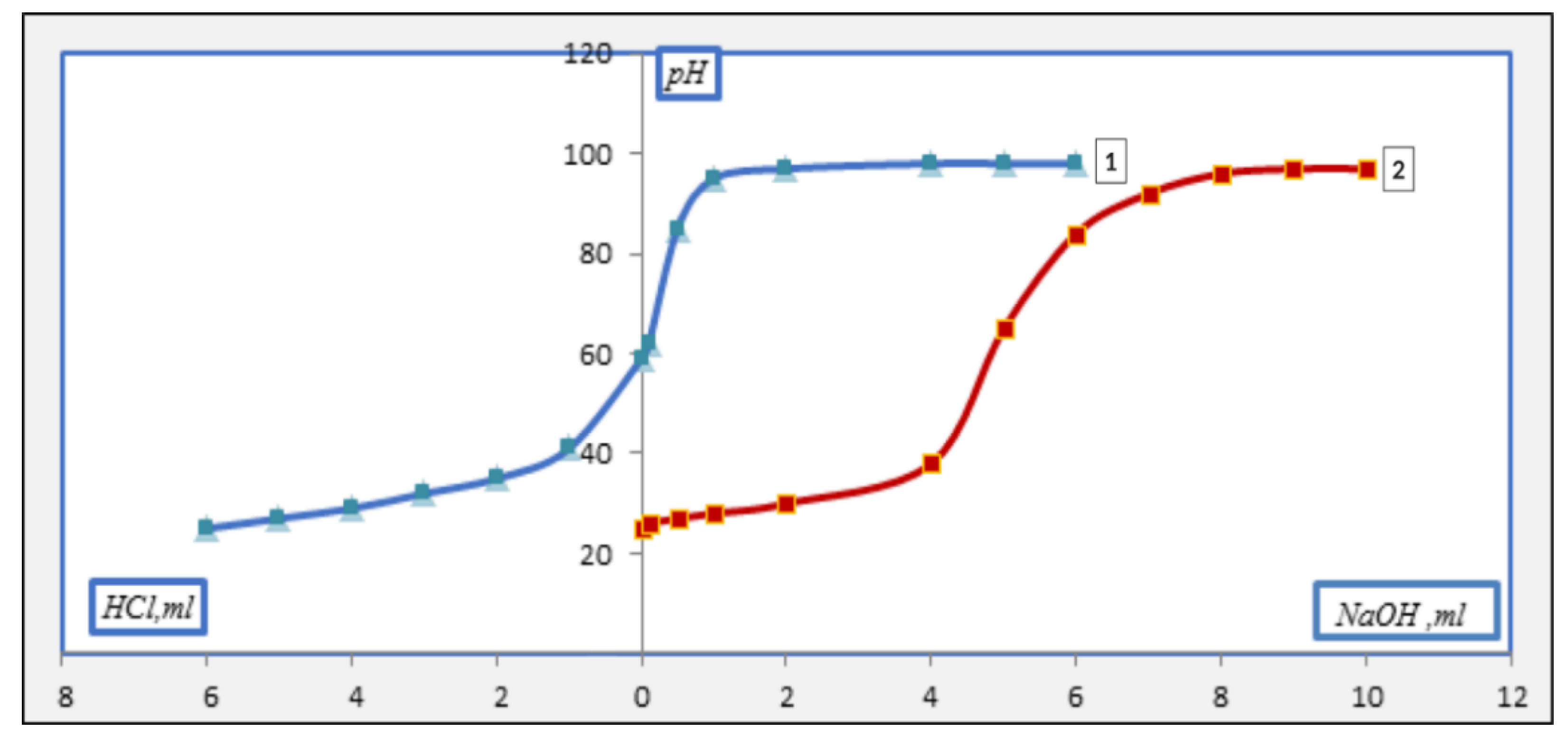

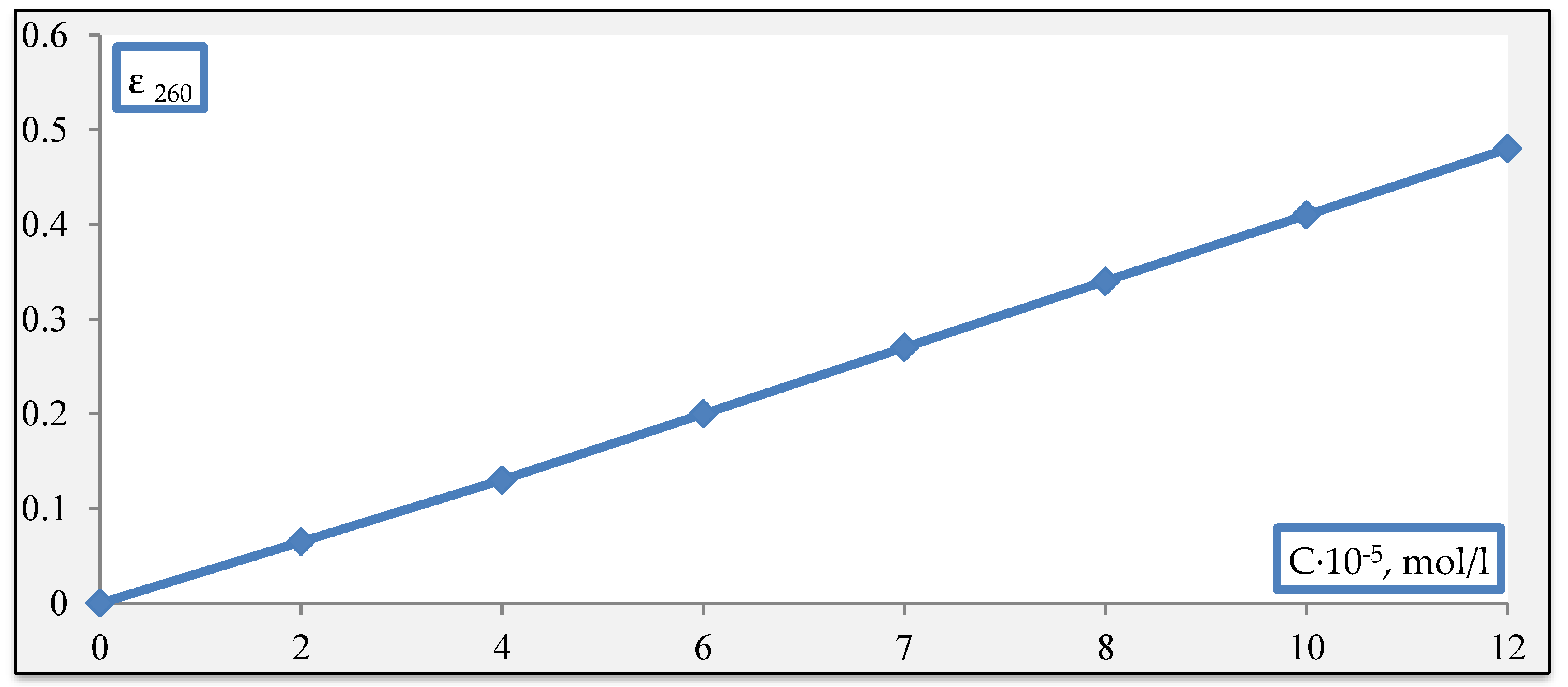

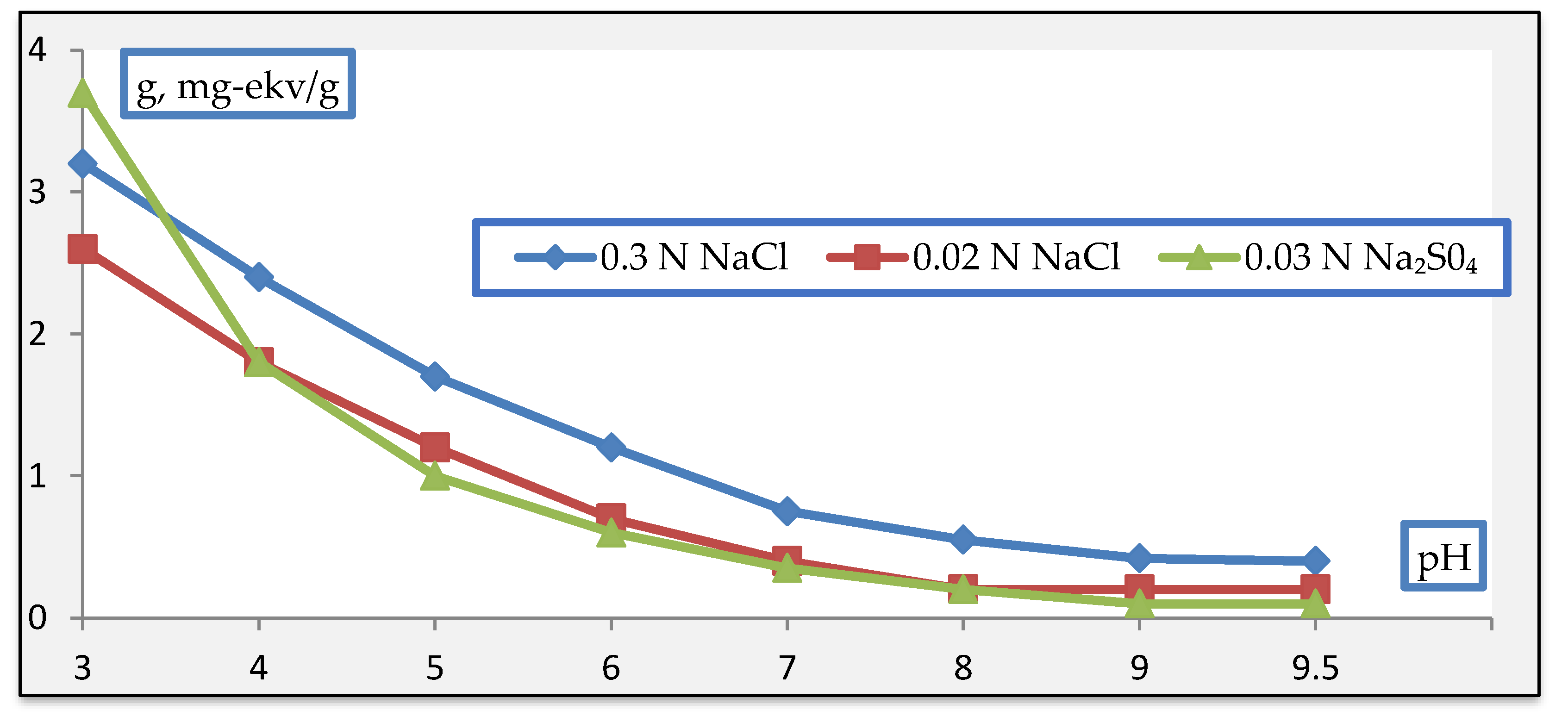
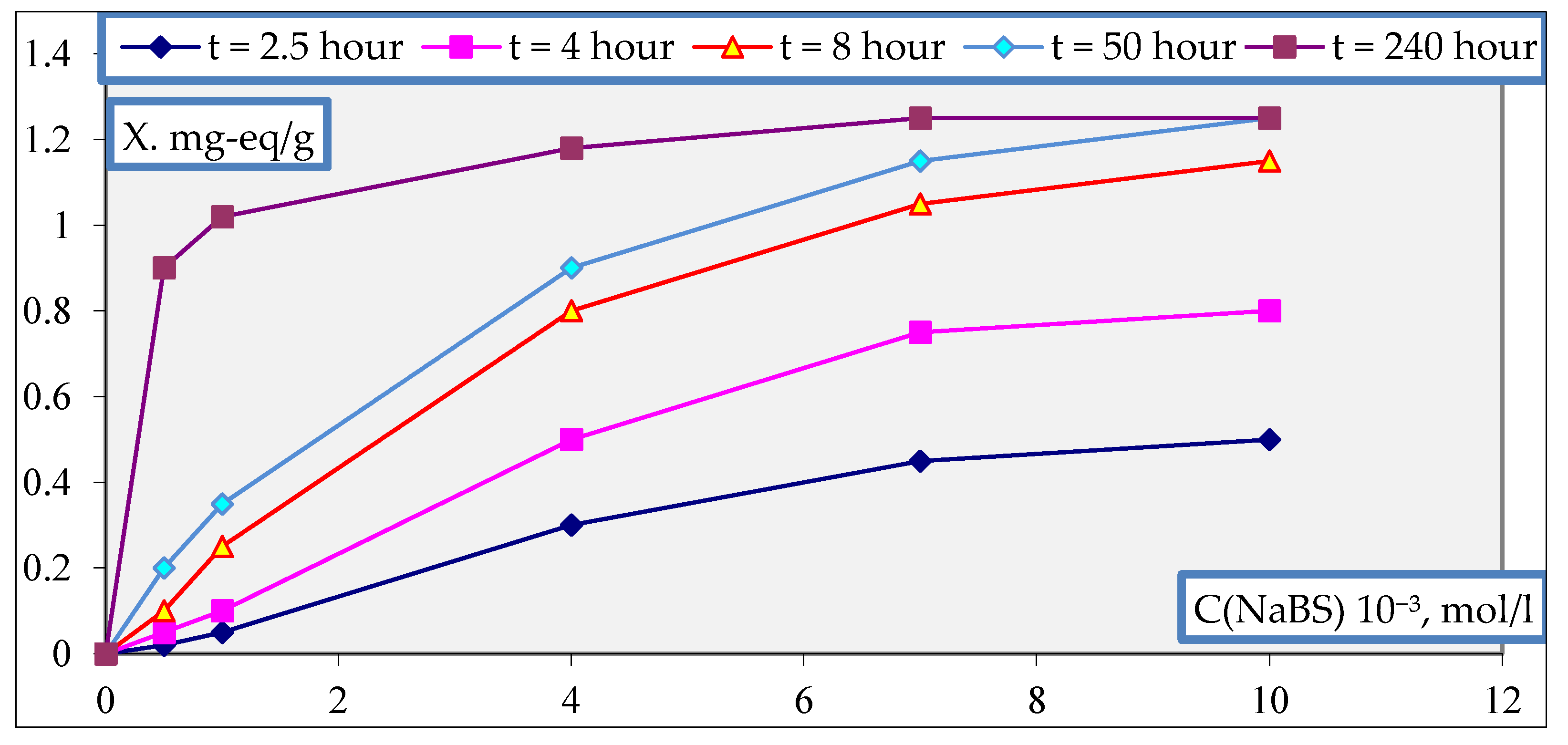
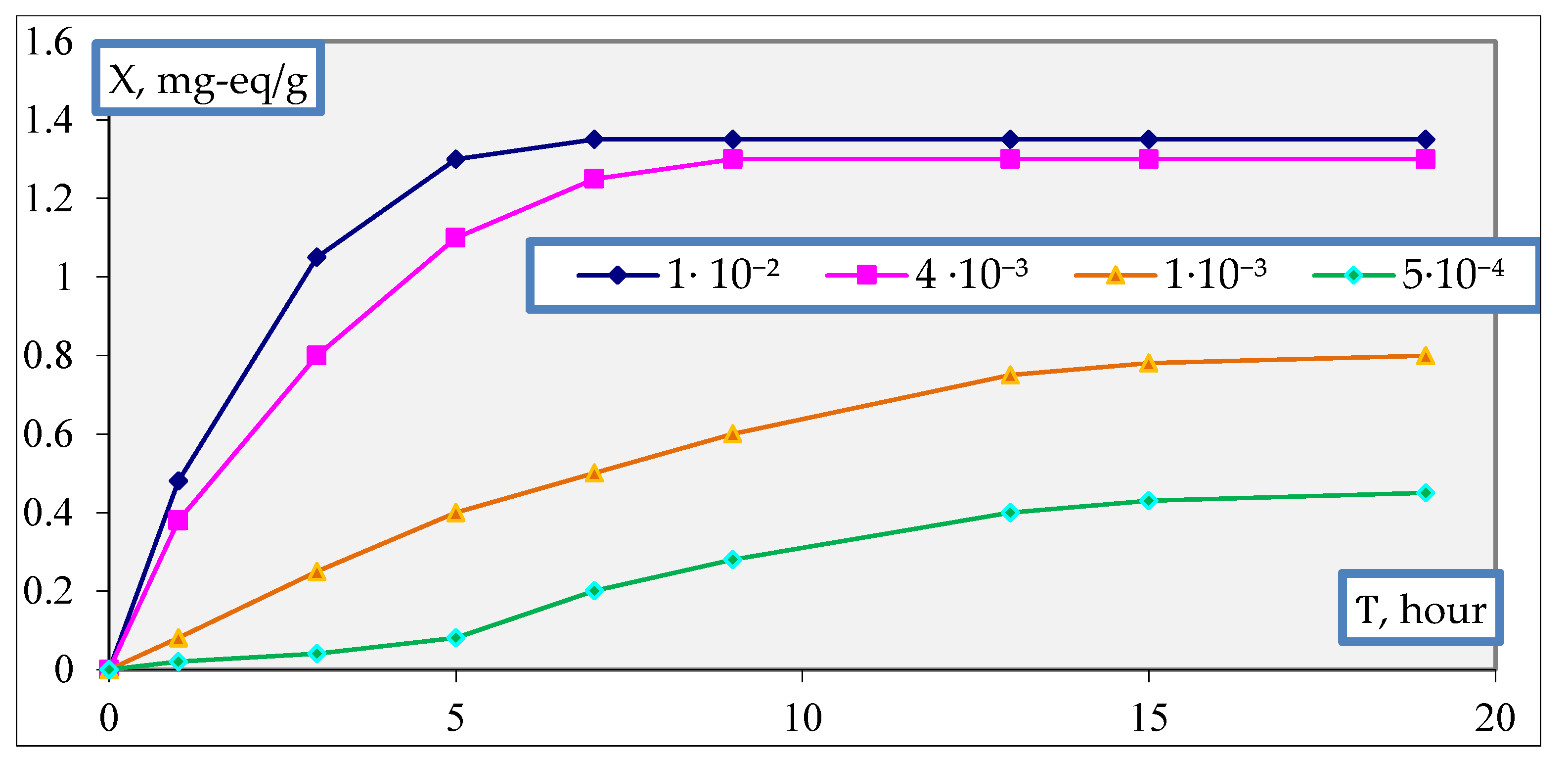
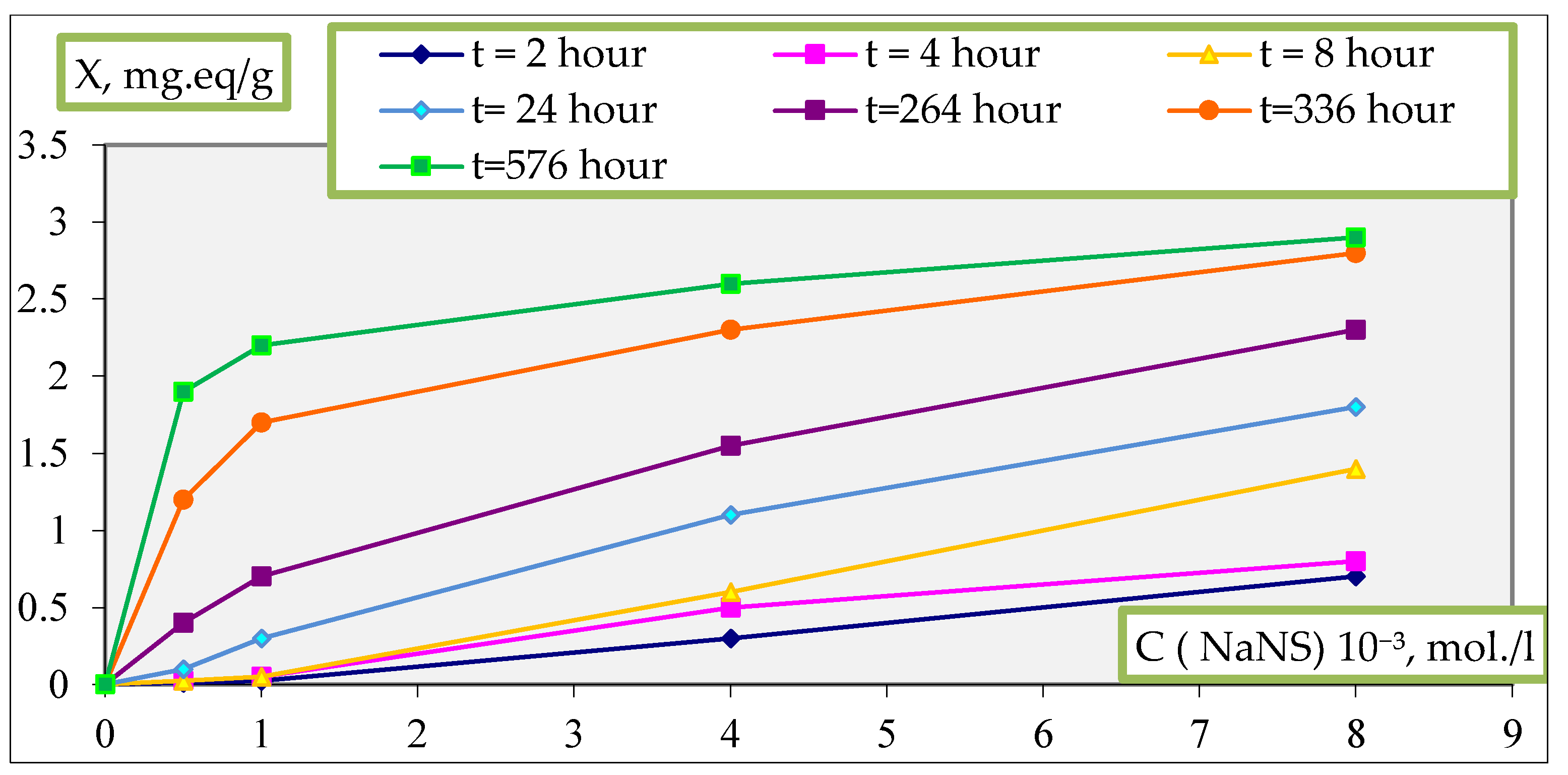
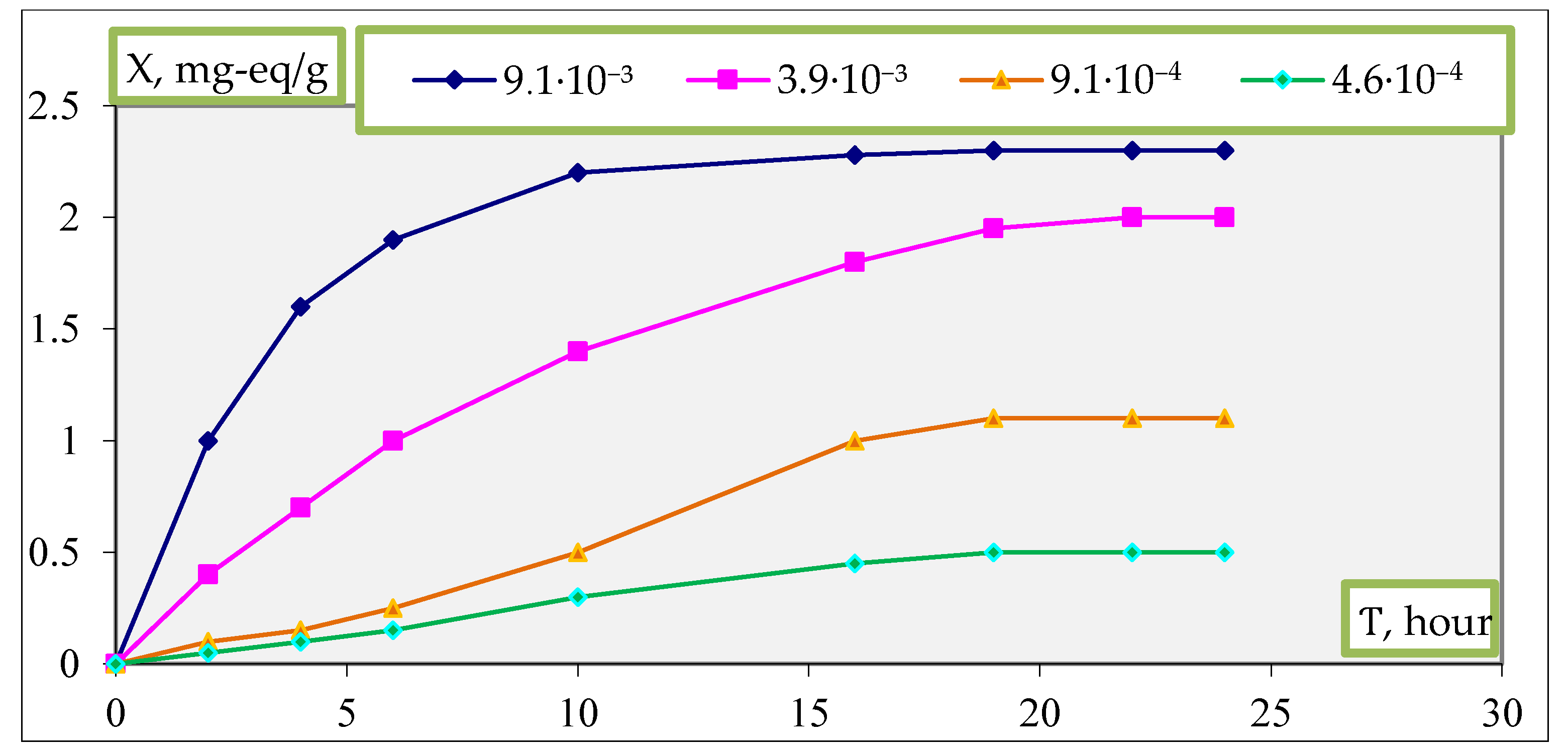

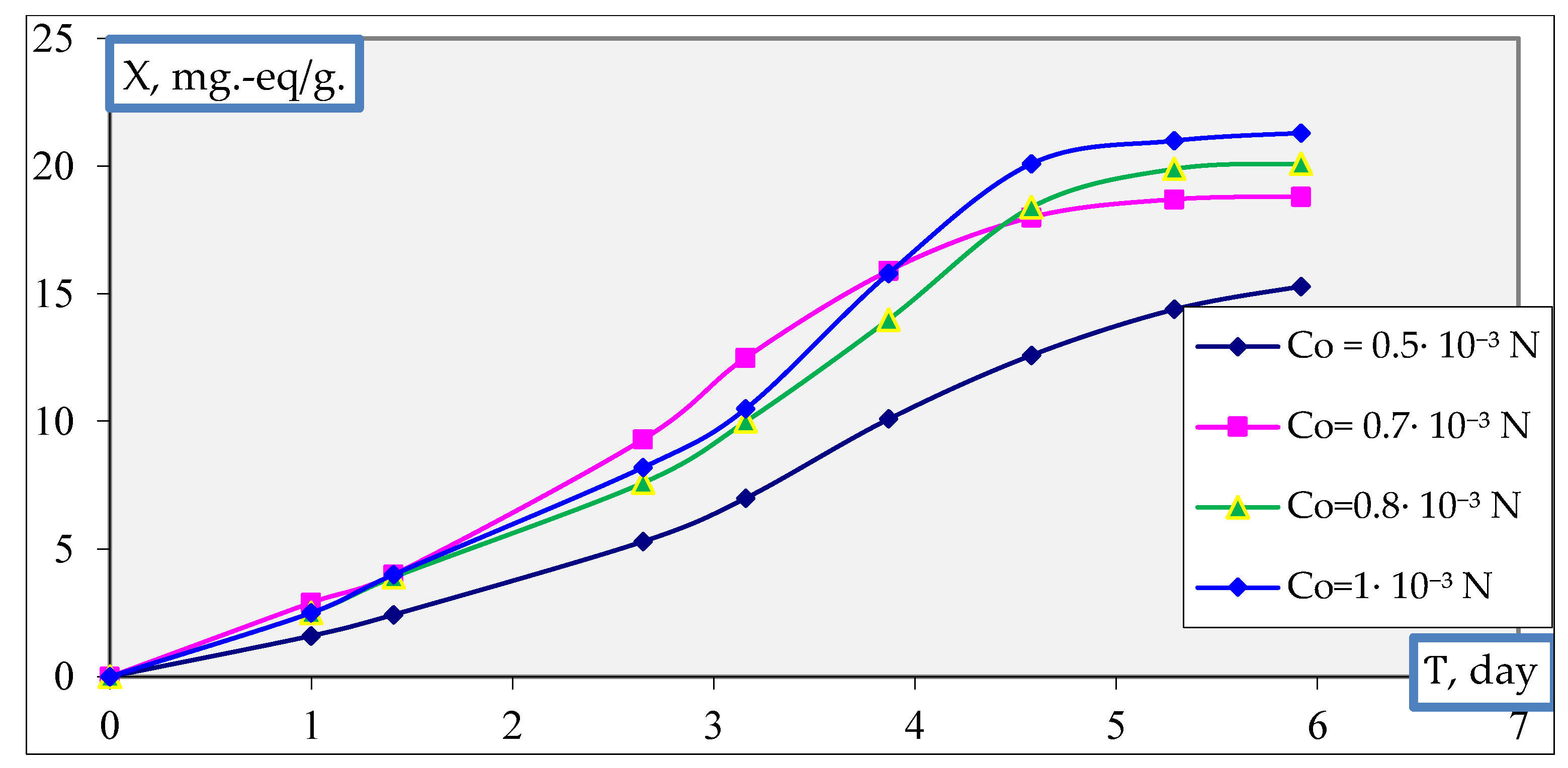
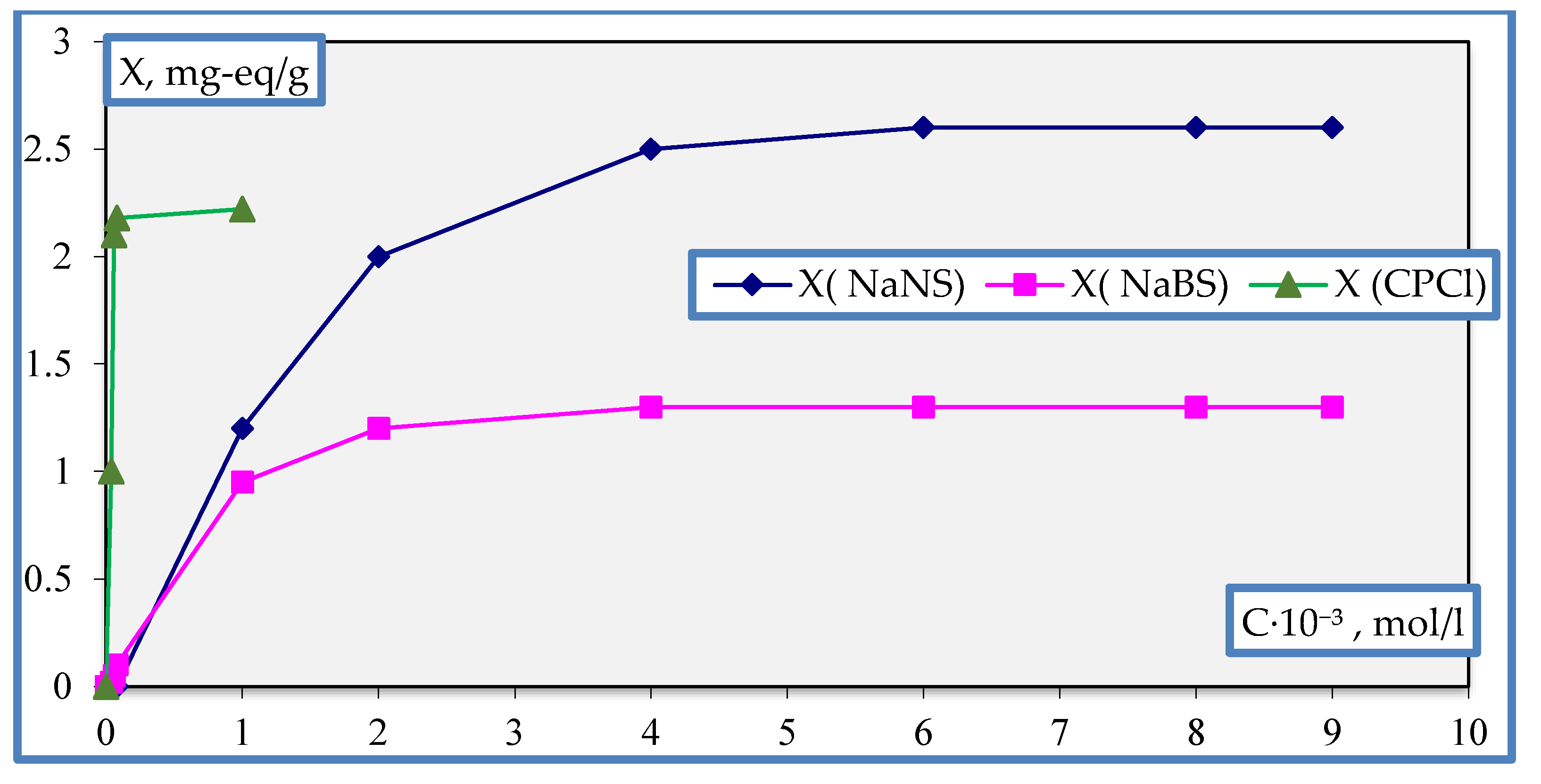
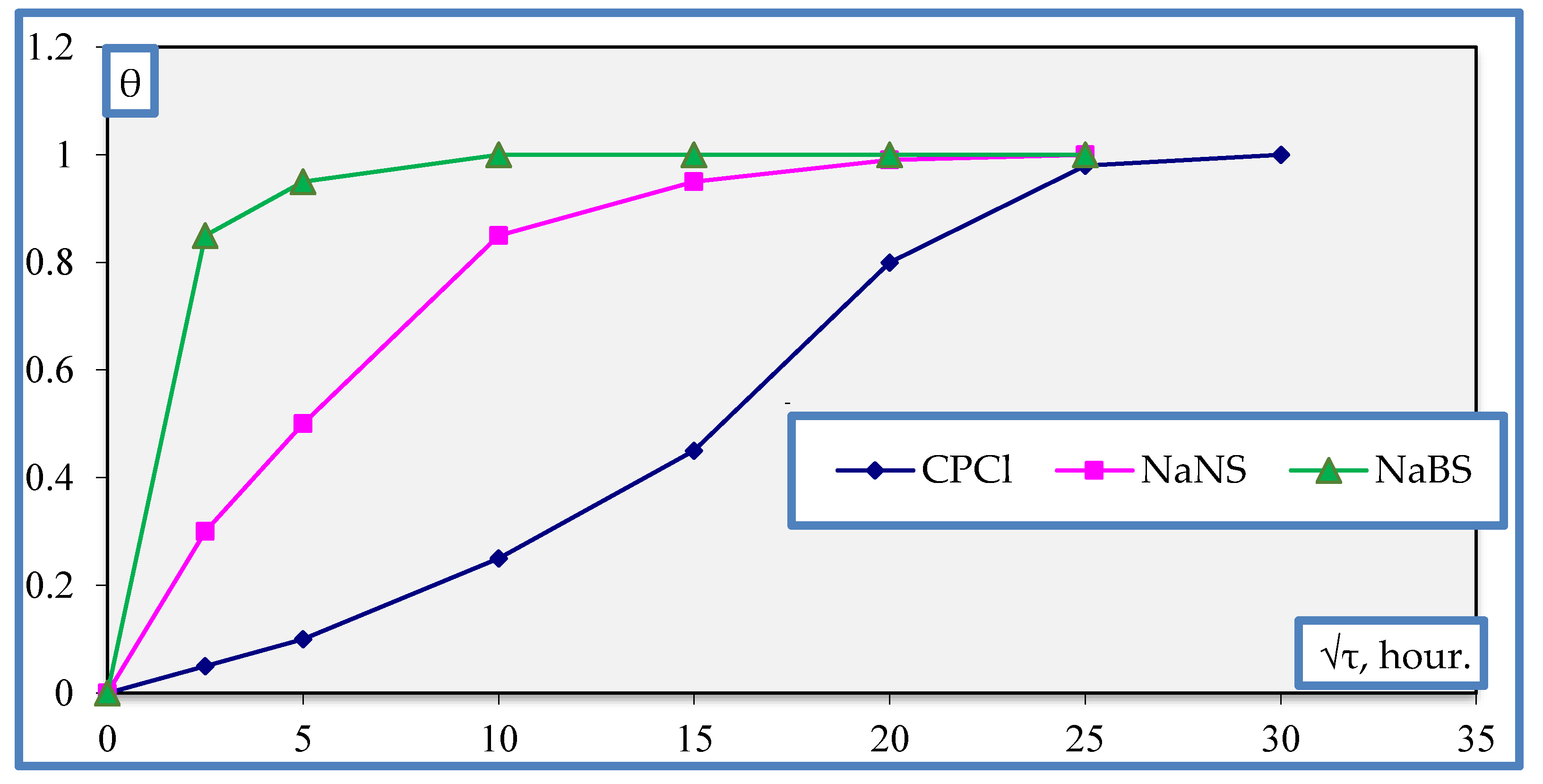
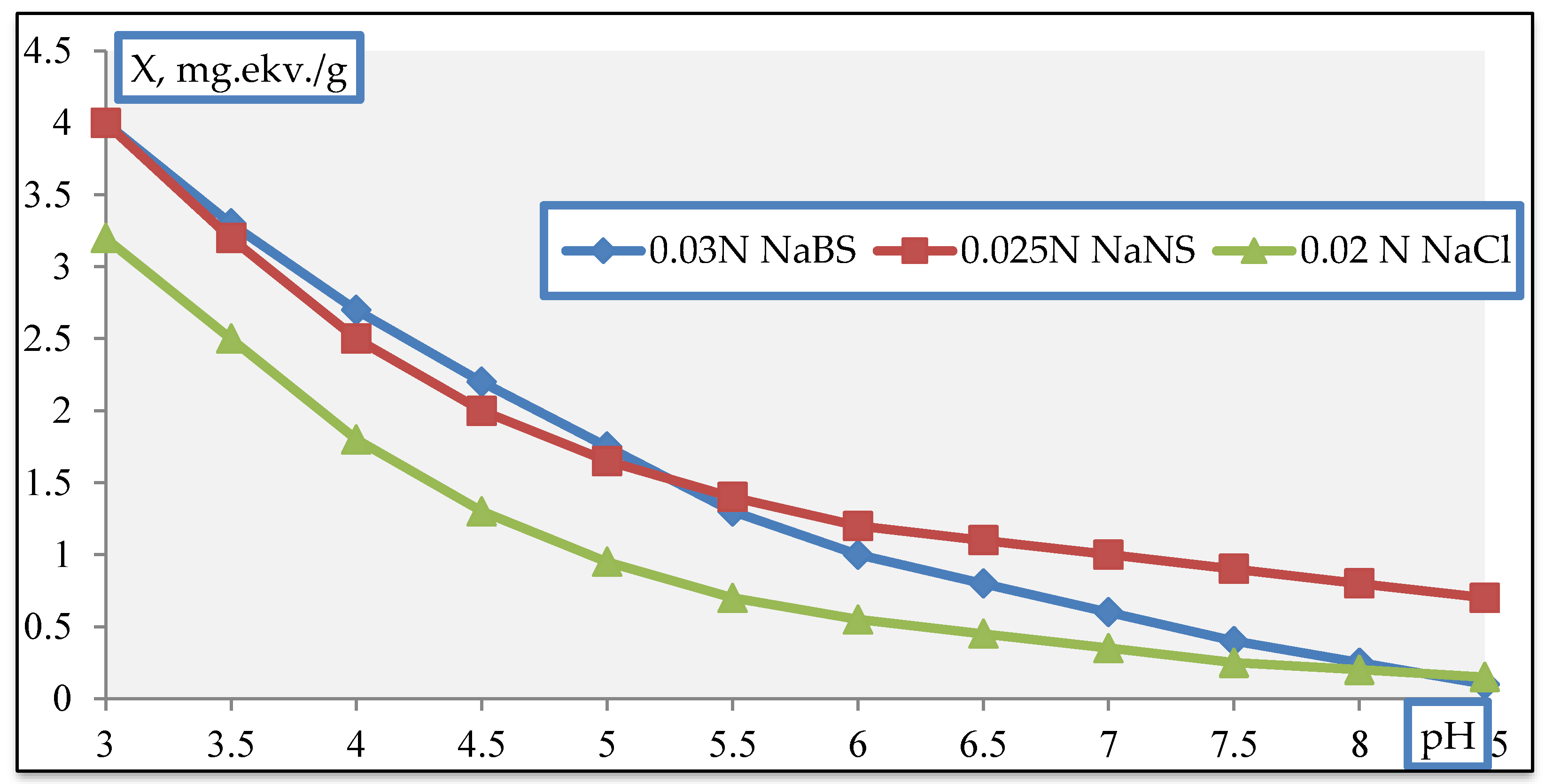
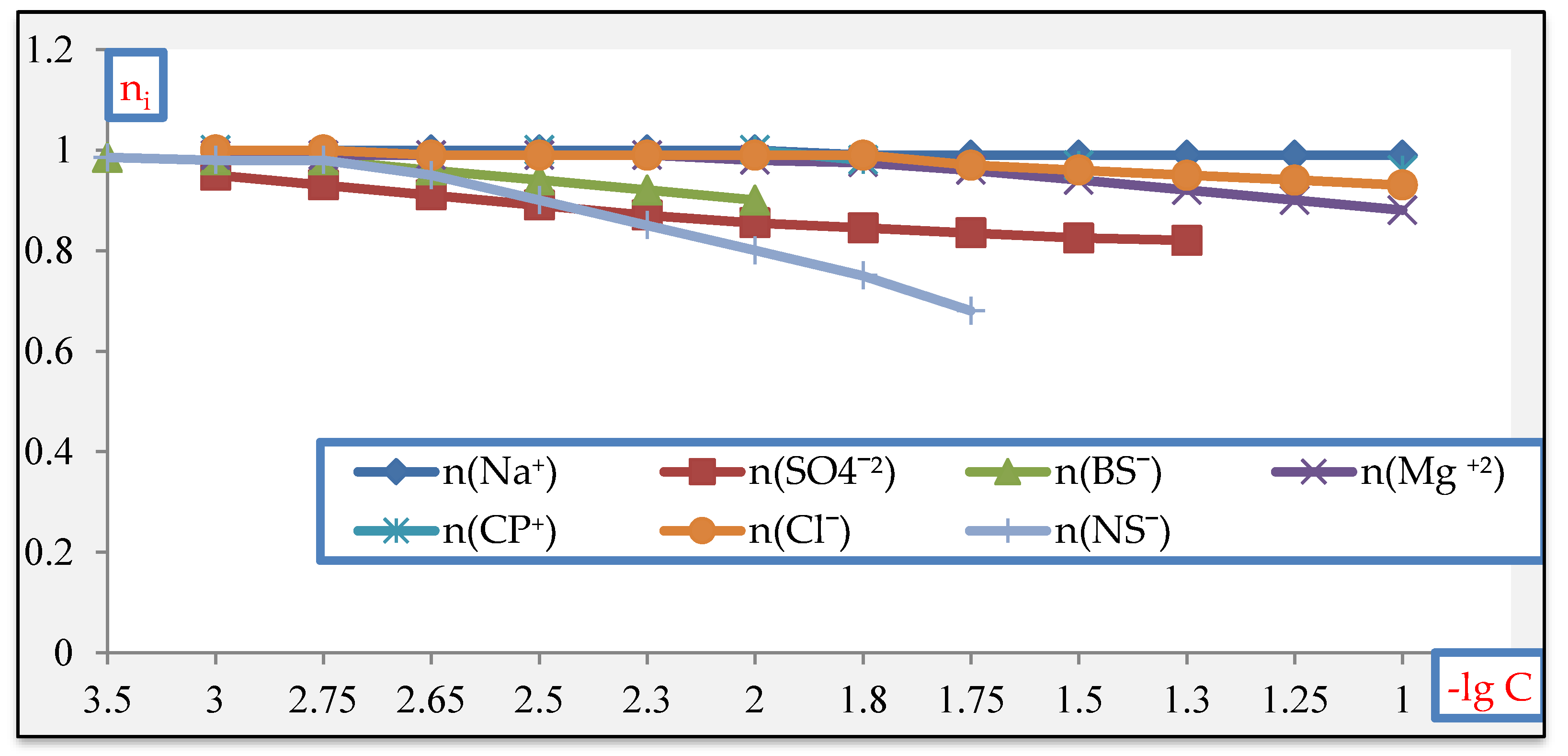
| System | Total Porosity | Degree of Swelling | Moisture Content |
|---|---|---|---|
| MK-40- NaCl | 0.56 | 0.88 | 0.40 |
| MK-40- NaBS | 0.47 | 0.41 | 0.32 |
| MK-40- NaNS | 0.32 | 0.19 | 0.20 |
| MA-40- NaCl | 0.34 | 0.50 | 0.41 |
| MA-40- CPCl | 0.21 | 0.32 | 0.26 |
| Membrane-Adsorbed Counterion | Electrolyte | Concentration mmol/L | ni |
|---|---|---|---|
| MK-40- Na+ | NaCl | 1 | 1.0 ± 0.02 |
| MK-40- Ba+2 | BaCl2 | 1 | 0.73 ± 0.02 |
| MK-40- CP+ | NaCl | 1 | 0.37 ± 0.02 (n(Na+)) |
| MA-40- Cl− | NaCl | 1 | 1.0 ± 0.02 |
| MA-40- OH− | NaOH | 15 | 0.87 ± 0.02 |
| MA-40- NS− | NaBS | 0.5 | 0.98 ± 0.02 |
| MA-40- NS− | NaBS | 2 | 0.97 ± 0.02 |
| MA-40- NS− | NaBS | 10 | 0.87 ± 0.02 |
| MA-40- NS− | NaNS | 0.5 | 0.97 ± 0.02 |
| MA-40- NS− | NaNS | 2 | 0.97 ± 0.02 |
| MA-40- NS− | NaNS | 10 | 0.81 ± 0.02 |
| MA-40- NS− | NaNS | 15 | 0.77 ± 0.02 |
Publisher’s Note: MDPI stays neutral with regard to jurisdictional claims in published maps and institutional affiliations. |
© 2020 by the authors. Licensee MDPI, Basel, Switzerland. This article is an open access article distributed under the terms and conditions of the Creative Commons Attribution (CC BY) license (http://creativecommons.org/licenses/by/4.0/).
Share and Cite
Bejanidze, I.; Petrov, O.; Pohrebennyk, V.; Kharebava, T.; Nakashidze, N.; Didmanidze, N.; Davitadze, N.; Petrov, A. Sorption of Organic Electrolytes and Surfactants from Natural Waters by Heterogeneous Membranes. Appl. Sci. 2020, 10, 7383. https://doi.org/10.3390/app10207383
Bejanidze I, Petrov O, Pohrebennyk V, Kharebava T, Nakashidze N, Didmanidze N, Davitadze N, Petrov A. Sorption of Organic Electrolytes and Surfactants from Natural Waters by Heterogeneous Membranes. Applied Sciences. 2020; 10(20):7383. https://doi.org/10.3390/app10207383
Chicago/Turabian StyleBejanidze, Irina, Oleksandr Petrov, Volodymyr Pohrebennyk, Tina Kharebava, Nunu Nakashidze, Nato Didmanidze, Nazi Davitadze, and Anton Petrov. 2020. "Sorption of Organic Electrolytes and Surfactants from Natural Waters by Heterogeneous Membranes" Applied Sciences 10, no. 20: 7383. https://doi.org/10.3390/app10207383
APA StyleBejanidze, I., Petrov, O., Pohrebennyk, V., Kharebava, T., Nakashidze, N., Didmanidze, N., Davitadze, N., & Petrov, A. (2020). Sorption of Organic Electrolytes and Surfactants from Natural Waters by Heterogeneous Membranes. Applied Sciences, 10(20), 7383. https://doi.org/10.3390/app10207383





